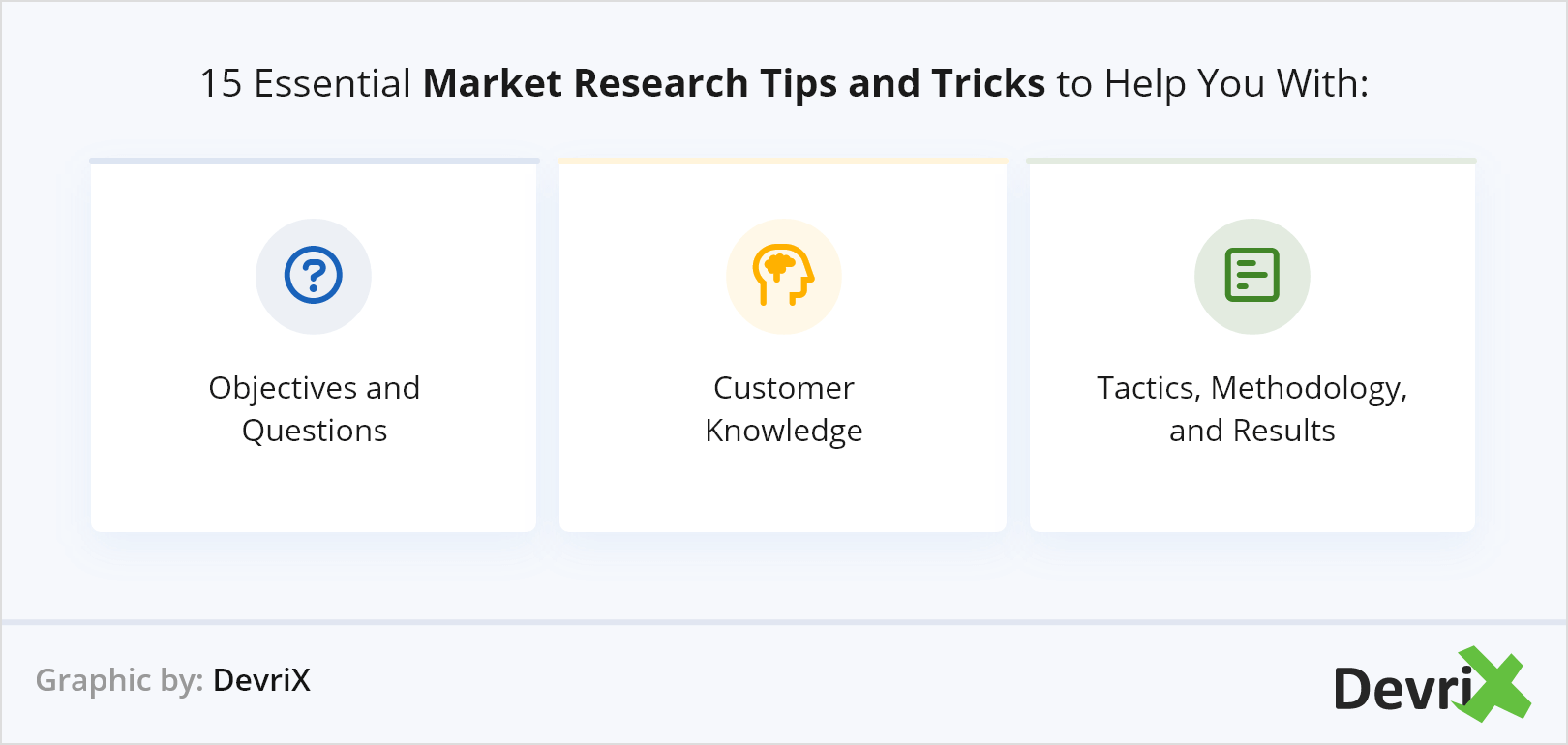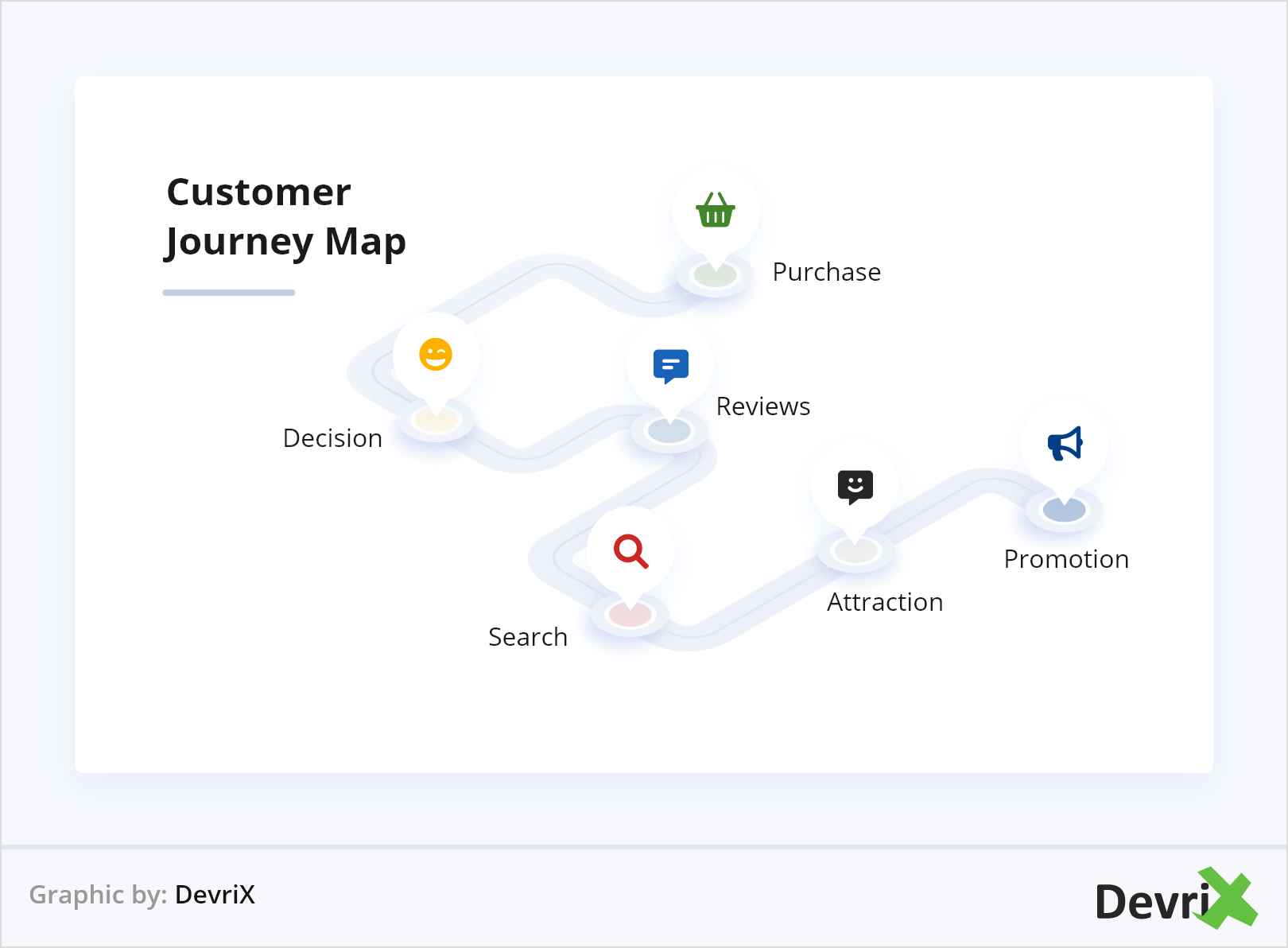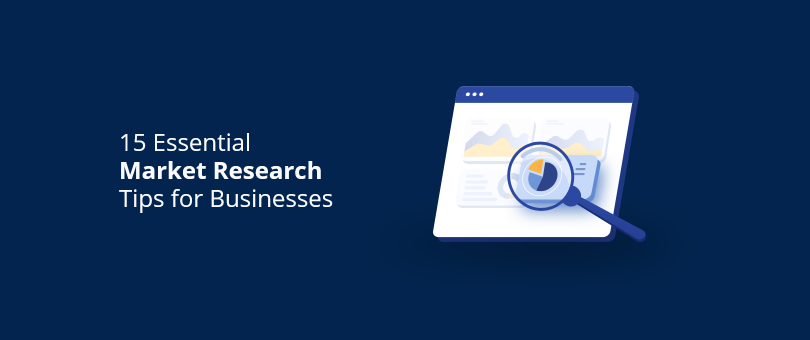Market research is an ongoing process that delivers valuable information you can leverage in making data-driven decisions for your company. Some of the most lucrative solutions it provides include, but are not limited to, business growth, product development, consumer data acquisition, and competitive analysis.
The marketplace is constantly changing and so are consumer habits and behavior. By studying the environment and regularly updating your data, you can make sure that your company will stay on top of new trends and prosper.
Although, simply collecting information and statistics is rarely enough to help you make useful conclusions and take actionable steps. There are specifics to it that take time and practice to master, and knowing them can be the difference between obtaining valuable results and wasting your time.
In this article, we’ve listed 15 essential market research tips and tricks, grouped into three sections:
- Objectives and Questions
- Customer Knowledge
- Tactics, Methodology, and Results
Following this advice will give you a headstart and allow you to study the market like a pro.
If you are new to the field, you can begin by reading our other articles on the topic:
- Market Research 101: From Beginner to Advanced
- Conducting Market Research: 6 Methods to Explore
- How to Conduct Market Research a Step-By-Step Guide
- How to Use Customer Surveys to Improve Your Product
- Your Complete Data Analytics Guide to Help Improve Your Business

Objectives and Questions
Following the natural logic of market research, we’ll start with tips for defining your objectives and questions:
1. List Your Objectives
Market research begins with defining your objectives. If you are not sure what you want to accomplish with the information you gather, the results will also be unclear and you might end up wasting precious time without learning anything helpful.
Listing your objectives will help you to stay on track and have a benchmark to refer back to. Be clear about what your goal is, identify how you can achieve it, and make a research plan.
2. Phrase Your Questions Carefully
Simply put, asking the wrong questions will deliver the wrong answers.
You should use the information you gather at different stages to update and refine your phrasing.
If your sentence structure or your wording is too complicated, people might not understand the question correctly and experience difficulty providing an answer.
A simple rephrasing can go a long way and make it clearer what you mean.
3. Test Your Questions

To minimize the risk of mistakes, you can test your questions on a small sample before you start to research. This way you can analyze how participants respond, clear up misunderstandings, and make adjustments.
If you don’t want to spare candidates from your target sample on testing out potentially flawed questions, you can put the survey to the proof with a group of your colleagues who are not involved in the research. Although they won’t fit your customer’s profile, they can still give you a different perspective on phrasing and readability.
4. Abstain From Asking Loaded Questions
Loaded questions have in-build assumptions that may or may not be correct. They can be confusing to people, and if the assumption was wrong in the first place, there will be no right answer without further clarifications.
For example, “Do you enjoy using our product?” is a yes or no question that implies that the customer has already used the product, but if they have not, then either answer will be wrong. It’s something you can ask only a person that you are absolutely sure has used your product.
5. Don’t Do Leading Questions
The same as in law, in research, leading questions are suggestive in nature and push the respondent to answer in an implied way. Since your company can benefit only from genuine and sincere information, such tactics should be avoided because they may compromise the integrity of the results and make them biased.
An example of a leading question is “Are you satisfied with the superb quality of our services?” Describing your services as superb leads the customers towards the same, even if they don’t feel that the level of quality is that good.
6. Close Interviews With an Open-Ended Question

Inexperienced researchers are often reluctant to ask open-ended questions because they believe the answers would be too random and difficult to process and measure.
However, when placed at the end of an interview or even a survey, these queries are defined by the context of the conversation so far. This means that the subject is already thinking in the direction you want them to. And since the respondents fit a common profile, it’s very probable that there will be clearly distinguishable patterns in their answers, making the data easier to analyze.
Some open-ended questions you can wrap up the conversation with are:
- Is there anything else you’d like to add?
- Are there any recommendations you’d like to make?
- How can our services/products serve you better?
While closed-ended questions limit the participants’ freedom to express their opinion, open-ended ones allow them to speak their minds. This will not only make the customer feel you value their opinion but may lead to valuable but unexpected revelations.
Customer Knowledge
In this section, we’ll focus on essential tips that will help you when gathering information about your customers and building marketing persona profiles:
7. Learn About Your Customers
Customer knowledge is the core of market research. Simply building profiles with demographics and basic information rarely gives you enough to know who someone is. People are complicated beings driven by different personal, professional, emotional, and rational motivations.
To fully understand your target audience as a whole, you should first learn about the individual’s feelings, needs, and preferences. Studying them in depth will allow you to create accurate buyer personas, and identify the right sample for your research.
8. Walk a Mile in Your Customer’s Shoes

Once you’ve analyzed your customers’ profiles and personalities, you should try to learn more about their habits, daily routines, and problems.
The information you’ve gathered can be used to create a customer journey map visualizing their personal and work life and the touchpoints with your business.
Walking a mile in your client’s shoes will allow you to understand them better, and ask more on-point questions in the next stages of the research.
9. Don’t Waste Time on the Wrong Audience
Finding a large enough population matching the ideal customer profile you defined for the research can be tough. Even when you have segmented all the customer databases at your disposal, you may still come short.
However tempting as it is, you should avoid including in your sample people who don’t fit the profile. They may help you reach the benchmark to make the data statistically relevant, but it will affect the accuracy of the results and may compromise the whole research.
In a way, knowing who is not on your target list is just as important as knowing who is.
10. Focus on the Customer, Not on Yourself
The market defines the business. Although a company can affect how the market changes and shape it over time, it cannot do it without deep knowledge of the customer. In a nutshell, that’s exactly the point of market research.
That said, it’s easy to slip into thinking that your efforts are about pushing forward what your company needs when they should actually be about staying ahead of what your customer wants.
The overall goal of the research, of course, is to leverage information for business gain. But your objectives en route should be to understand how the customer can benefit from your goals, so you can reverse-engineer their needs into your solutions.
In other words, while you are conducting your study, your focus should be on the customer. Once you have the results, you can make conclusions about how to leverage them for your company.
Tactics, Methodology, and Results
In this last section, we’ve gathered some final tips and tricks that will help you master managing the tactics, methodology, and results of market research:
11. Study the Competition
Competitors are part of the market environment and analyzing them can provide additional context to the results of your research. Regardless of what your goals are, knowing what other companies in your niche are doing and how customers feel about it will always be an advantage.
Updating your information about the competition and aligning it with your own objectives, will give you a strategic advantage and a different perspective.
12. Combine Different Research Methods
Every market research method has its limitations and using only one of them is not sufficient to achieve comprehensive results.
By combining different techniques, you can explore the problem from all angles, gain a broader perspective, and have a better understanding of possible solutions.
For example, if you want to break into a new market or launch a new product, in the initial stages of your study, you can do secondary research to obtain a more general overview of the market. Then, you can continue with focus groups and personal interviews that can provide qualitative data like unexpected customer insights, purchasing habits, and behavior patterns of your target audience.
Once you know your customers better, you can finish the study off by conducting surveys with closed-ended questions. This last step will enable you to leverage the results you’ve accumulated so far into obtaining quantitative data that can be used to make statistically valid conclusions.
13. Balance Qualitative and Quantitative Data

Qualitative data is often underestimated because it’s difficult to organize and present in reports. However, numbers and statistics can be easily misunderstood without context. That’s what qualitative results are for.
Analyzing them and cross-referencing the information with quantitative data will allow you to make sense of the numbers and understand what they mean.
To make valid and relevant conclusions, you should balance what you take from all methods, tactics, and sources, and include it in your report.
14. Open Your Report With a Summary
Once you are done with gathering data for your market research, you should organize it in a report that can be presented to team members and stakeholders.
However, raw facts and data can be overwhelming and, well, boring. To make your report worth the viewer’s time, it’s important to structure the information in a way that will make sense even to someone completely unfamiliar with the topic.
Consider starting with a summary of the most important conclusions to catch the viewer’s attention and give them clues about what to look for in the body of the report. This way, the rest of the information will be easier to digest and understand.
You can also consider using more engaging ways to visualize data like videos, interactive presentations, or an infographic.
15. Update the Research Often
Market research is not something you can do only once and then forget about it. It’s an ongoing process and the results should be updated regularly.
The market is constantly changing and evolving, and what you’ve discovered half a year ago may not be valid today. Old data can be misleading and take your business decisions in the wrong direction.
Bottom Line
Conducting market research can be beneficial for practically any aspect of your business.
By following your objectives throughout the study, experimenting with different techniques, and refining your questions at every stage, you can obtain credible knowledge about your customers and truly understand them. This will allow you to provide an exquisite UX, and grow your operations.
Although you need to keep in mind that mastering research takes knowledge, practice, and patience before it can help you improve your skills and accelerate your progress in the field.




